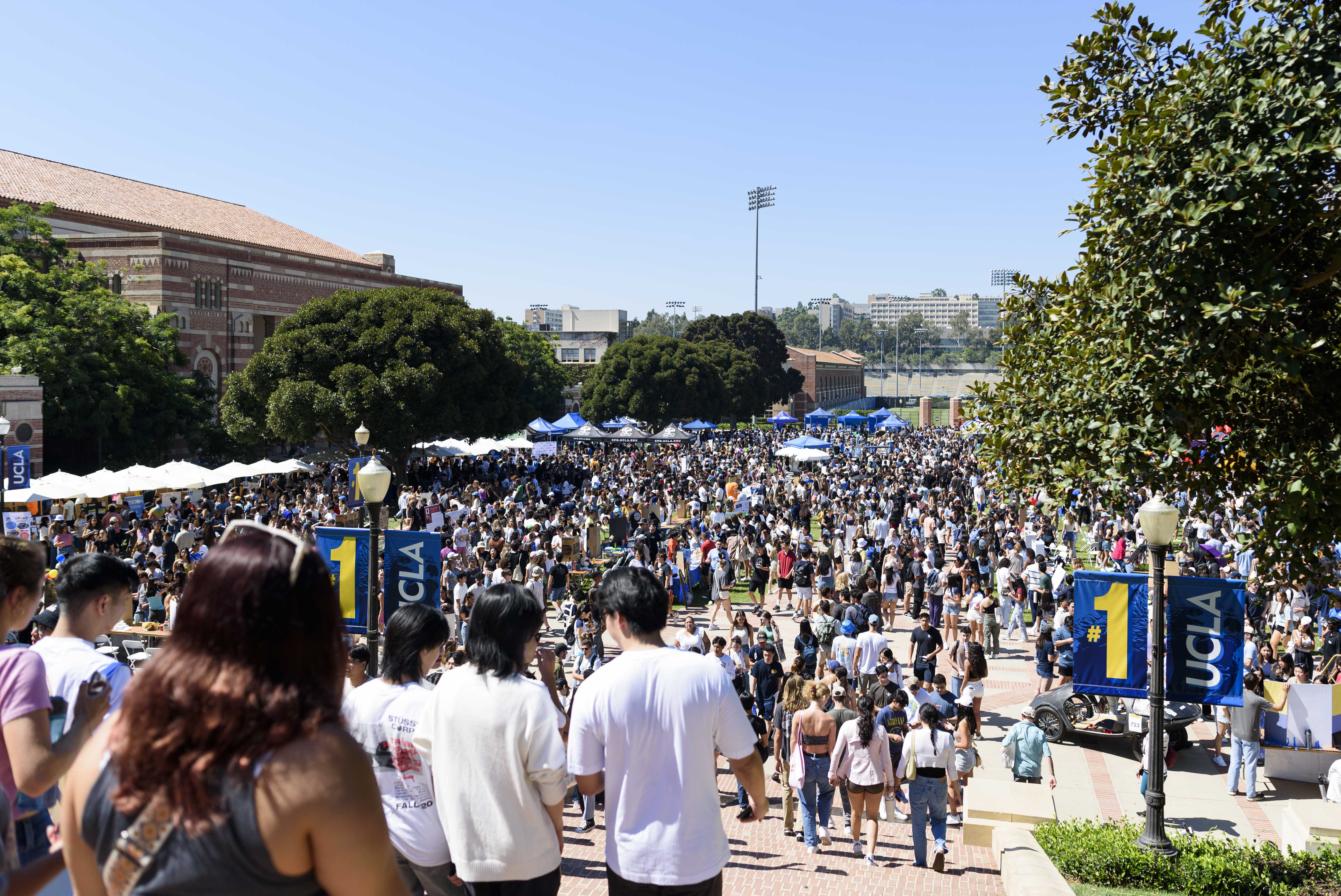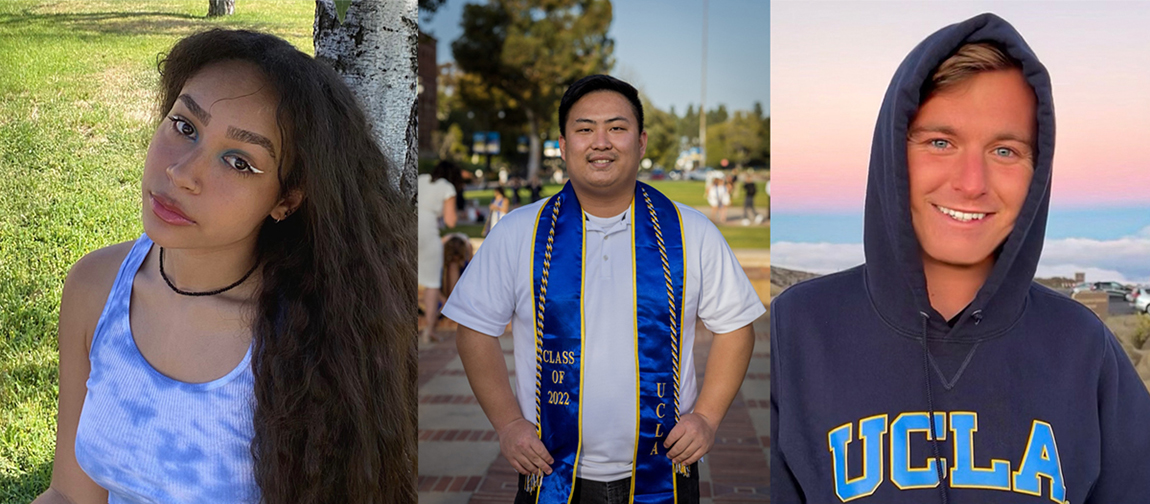Opinion: Student organizations must be made more accessible to transfer students

A crowd of students walking through booths during the Enormous Activities Fair is pictured.(Myka Fromm/Assistant Photo editor)
By Laura Gulbinas
Nov. 28, 2023 8:23 p.m.
This post was updated Nov. 28 at 9:44 p.m.
As prospective transfers all over California face the approaching undergraduate transfer application deadline, they eagerly look to the schools they hope to attend for the next two years. Some may focus on prestige, others on campus beauty, and many on clubs and organizations offered.
As a key component of any college experience, student-run clubs and organizations allow students to interact with like-minded individuals as they explore their interests.
UCLA boasts over 1,200 clubs and claims that 74% of undergraduate students participate in these organizations. With clubs ranging across a variety of focuses – from sports and recreation to student government to arts and culture – UCLA seems to be a hub of student involvement.
Unfortunately for transfer students, these clubs are not as accessible as they are widely advertised to be, often because of regulations that limit their ability to join or pursue leadership positions given time constraints. As an institution committed to diversity, equity and inclusion, UCLA must better support its nontraditional student population from orientation onward.
Student-run clubs and organizations are crucial to the college experience, as involvement fosters social, academic, professional and personal development. According to a 2018-2019 survey of Ohio State University graduates, students who participated in at least one co-curricular activity were more satisfied with their overall college experience, more likely to obtain a job offer following graduation and more likely to express interest in postgraduate education.
Ian Bastida, a fourth-year English transfer student, said he found community in clubs that connected to his identity and passions such as the Latine Film and Theatre Association.
“It kind of made me feel like, ‘Oh, I do belong here,’” Bastida said. “I found my niche here as a transfer, and that’s what I really appreciate.”
While many incoming freshmen will have the chance to learn of these various clubs and organizations through an extensive three-day orientation and continuous guidance throughout their first year, transfers are often left behind. Receiving a SparkNotes version of the first-year orientation that only spans one day, transfers are often left confused or unaware of the many clubs and organizations UCLA offers.
Daria Rego, a fourth-year biochemistry and microbiology, immunology and molecular genetics transfer student, recalled her rushed orientation, which was primarily concerned with academics over co-curricular activities.
“I did not really learn about any club side of things. I was mostly focused and worried about enrollment and academics and figuring out my transcript issues,” Rego said. “I missed out on a lot of opportunities.”
After orientation, students are encouraged to attend various events such as the Enormous Activities Fair and Transferpalooza.
Transferpalooza, although catered specifically toward transfer students, often fails to reach the size and scope of the Enormous Activities Fair. Hosted every fall quarter, the Enormous Activities Fair features over 500 clubs and student organizations. Although it is a great way for students to gain extensive knowledge of opportunities available, the labyrinth of booths and sheer size of the gathering could make it nearly impossible for new students to navigate.
“It can be somewhat overwhelming,” said Jade Smith, a fourth-year biology student. “You’re getting bombarded by a lot of people saying, ‘Join our club, join our club.’”
Like Smith, Rego also expressed concerns with the EAF as a transfer student looking for transfer-specific clubs.
“Transfer clubs as well are very spread out,” Rego said. “I think I went through every single aisle, and there’s one transfer club here, one transfer club there.”
Even after taking matters into their own hands by attending various on-campus events and joining Discord, Slack and GroupMe chats, transfers face grueling applications, unresponsive club leadership and transfer bias.
While more identity- and activity-based clubs may invite all who are interested to join, many professional clubs have high standards for admission.
For instance, professional fraternities such as Kappa Alpha Pi, UCLA’s premier co-ed pre-law fraternity, and Phi Delta Epsilon, UCLA’s international medical fraternity, require lengthy applications, weeklong rush events and several stages of interviews for a chance for a bid.
Other clubs such as Bruin Consulting pride themselves on acceptance rates lower than the university’s – ranging around 2% to 3% – arguing that this selectivity is meant to provide members with more opportunities and chances for development. However, these club admissions processes often leave transfer students overlooked because of rigid timelines and requirements that fail to accommodate transfer students’ adjusted degree plans.
“I feel like often, a lot of these clubs did cater to freshmen,” Bastida said. “A lot of transfers are also older students who followed a less traditional trajectory to higher education. It’s going to take more work, but I think it’s important that every club follows the necessary steps to be inclusive to all these … demographics that attend UCLA.”
With 23.9% of UCLA’s student population having transferred from another academic institution, UCLA must look for ways to represent nontraditional students as best as possible.
Starting from orientation, transfer students should be offered the chance to explore clubs and organizations in addition to addressing their academic needs. Clubs and organizations should be held to the same standards of admission as the university – with an emphasis on diversity, equity and inclusion – and promoted to both freshmen and transfer students equally.
As transfer students may already face additional challenges because of their nontraditional educational paths, inaccessibility to clubs and organizations presents another burden preventing them from the UCLA experience they hope for.
“I really do feel like transfers are just immediately overwhelmed,” Rego said. “By the time they figure out their bearings, they have passed by a lot of opportunities.”
Transfer students deserve the chance to explore opportunities in student-run clubs and organizations that are accessible to all.





